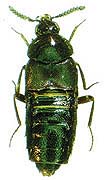Aleocharina
James S. Ashe (1947-2005) and Christian Maus- Aleochara
- Correa
- Cratoacrochara
- Creochara
- Ilarochara
- Leptogenophilus
- Lyperosterochara
- Ocyota
- Oxybessoglossa
- Palaeochara
- Paraleochara
- Paroxysmeme
- Piochardia
- Plesiochara
- Pseudocalea
Introduction
The subtribe Aleocharina is comprised of about 10 genera and approximately 450 species. Representatives of this group are known from throughout the World. The status of the subtribe and its included genera is very unstable because of uncertainties in the limits of the genus Aleochara and related genera and subgenera. The entire subtribe needs revision on a Worldwide basis. None of the recognized genera has received comprehensive revision, and their taxonomic status is uncertain.
The genus Charoxus Sharp, placed in the Aleocharini, and in the subtribe Aleocharina by default, by Kistner (1981) does not belong to this group. Frank and Thomas (1996) have reassigned Charoxus to the tribe Athetini.
Characteristics
The subtribe Aleocharina has not been fully characterized. It appears to include all of those taxa in the tribe Aleocharini that do not share the highly derived features of the Compactopediina and Hodoxenina. Thus, the characteristics of the subtribe Aleocharina are these same as those of the tribe Aleocharini. That is, the Aleocharina are characterized by the presence of 5-5-5 segmented tarsi, and a pseudosegment on the last segment of the maxillary and labial palpi, so that the maxillary and labial palpi appear to be 5-articled and 4-articled respectively (Lohse 1974, Seevers 1978, an illustration of this characteristic is available here), and at least some have a reticulated velum on the parameres of the aedeagus (Seevers 1978).
Discussion of Phylogenetic Relationships
Monophyly of the subtribe Aleocharina has not been investigated. However, it appears to be based exclusively on plesiomorphic characteristics in comparison to the other subtribes. In addition, there is no comprehensive study addressing the phylogeny of the included genera. ASSING & WUNDERLE (1997) propose that Pseudocalea is closely related to Aleochara and is possibly the sister group to Ocyota. This hypothesis is based on similarities in the mouthparts, genitalia and other features; however, they do not show that these similarities are synapomorphies. Consequently, the phylogenetic relationships among the genera of Aleocharina remains uncertain.
References
Frank, J. H. and M. C. Thomas. 1996. A new species of Charoxus (Coleoptera: Staphylinidae) from native figs (Ficus spp.) in Florida. Jour. New York Entomol. Soc. 104(1-2): 70-78.
Kistner, D. H. 1981. The reclassification of the genus Charoxus Sharp with the description of new species (Coleoptera: Staphylinidae). Jour. Kansas Entomol. Soc. 54: 587-598.
Lohse, G. A. 1974. Die Kaefer Mitteleuropas. Staphylinidae II (Hypocyphtinae and Aleocharinae). Goecke & Evers, Krefeld, Germany. 381 pp.
Seevers, C. H. 1978. A generic and tribal revision of the North American Aleocharinae (Coleoptera: Staphylinidae). Fieldiana: Zoology 71: vi + 1-275.
Title Illustrations

| Scientific Name | Aleochara (s.str.) lata |
|---|---|
| Location | Italy |
| Size | length 6.5 mm |
| Copyright |
© 1997 James S. Ashe (1947-2005)

|
| Scientific Name | Aleochara (Emplenota) pacifica |
|---|---|
| Location | Canada, B.C. |
| Size | length 5.6 mm |
| Copyright |
© 1997 James S. Ashe (1947-2005)

|
| Scientific Name | Aleochara (Xenochara) kamila |
|---|---|
| Location | France |
| Size | length 4.0 mm |
| Copyright |
© 1997 James S. Ashe (1947-2005)

|
| Scientific Name | Piochardia reitteri |
|---|---|
| Location | Albania |
| Size | length 3.5 mm |
| Copyright |
© 1997 James S. Ashe (1947-2005)

|
| Scientific Name | Pseudocalea brevicornis |
|---|---|
| Location | Italy |
| Size | length 5.0 mm |
| Copyright |
© 1998 James S. Ashe (1947-2005)

|
About This Page
Development of this page made possible by National Science Foundation PEET grant DEB 95-21755 to James S. Ashe and a DAAD grant D/97/05475 from the German Government to Christian Maus.
All images on this page copyright © 1997 James S. Ashe.
James S. Ashe (1947-2005)

University of Kansas, Lawrence, Kansas, USA

Bayer CropScience AG, Institute for Ecotoxicology, Monheim, Germany
Correspondence regarding this page should be directed to James S. Ashe (1947-2005) at
Page copyright © 1997 James S. Ashe (1947-2005) and
All Rights Reserved.
- First online 11 September 1998
Citing this page:
Ashe (1947-2005), James S. and Christian Maus. 1998. Aleocharina. Version 11 September 1998 (under construction). http://tolweb.org/Aleocharina/9874/1998.09.11 in The Tree of Life Web Project, http://tolweb.org/
















 Go to quick links
Go to quick search
Go to navigation for this section of the ToL site
Go to detailed links for the ToL site
Go to quick links
Go to quick search
Go to navigation for this section of the ToL site
Go to detailed links for the ToL site